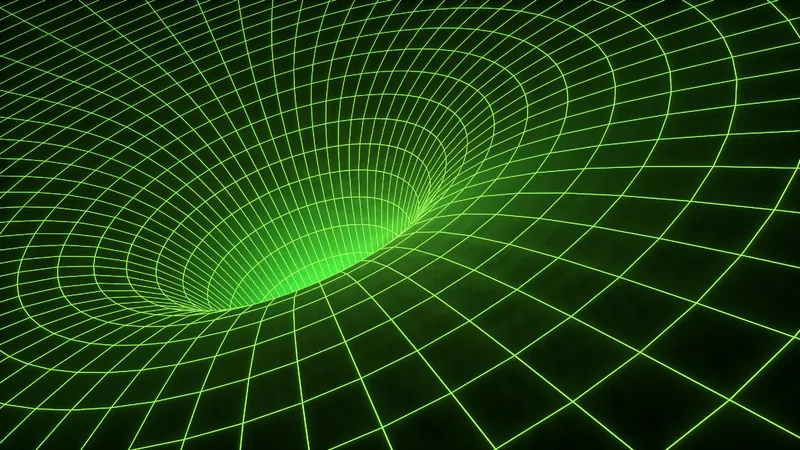
Astrophysics Breakthrough: New Discoveries in Black Hole Collisions and Gravitational Waves!
2025-05-14
Author: Jia
Unlocking Cosmic Secrets: The Collision of Black Holes!
A groundbreaking study published in *Nature* has revealed unprecedented details about the universe's most cataclysmic events: the collisions of black holes and neutron stars. Spearheaded by Professor Jan Plefka from Humboldt University of Berlin and Dr. Gustav Mogull from Queen Mary University of London, this international research team has set new standards in calculating the intricacies of gravitational waves.
Revolutionary Techniques: The Power of Quantum Insights!
Utilizing advanced techniques drawn from quantum field theory, the researchers achieved the fifth post-Minkowskian (5PM) order, providing crucial insights on scattering angles, radiated energy, and the energetic 'kick' or recoil of black holes. One of the most fascinating discoveries was the emergence of Calabi-Yau three-fold periods—complex geometric forms traditionally tied to string theory—within the equations describing these cosmic events. Once thought to be mere abstract concepts, these structures now play a vital role in understanding real astrophysical phenomena.
The Future is Bright: Enhancing Gravitational Wave Observations!
As gravitational wave observatories like LIGO ramp up their sensitivity and next-gen detectors like LISA loom on the horizon, the demand for accurate theoretical models has never been greater. Dr. Mogull emphasizes, "While the concept of black holes interacting may seem straightforward, the mathematical precision needed is monumental." This precision is especially critical for interpreting signals from intricate orbiting systems, where the dynamics are far removed from the traditional slow-moving black hole assumptions.
Revolutionizing Cosmic Understanding: The Impact of Gravitational Waves!
Gravitational waves—ripples in spacetime birthed by massive objects like colliding black holes—have transformed our comprehension of astrophysics since their first detection in 2015. Enhanced modeling of these waves enriches our grasp of cosmic phenomena, including the recoil of black holes, which has vital implications for the formation and evolution of galaxies.
Linking Math and Physics: A Groundbreaking Connection!
The astonishing discovery of Calabi-Yau structures links the vast universe of astrophysics with the intricate realm of quantum mechanics. Dr. Uhre Jakobsen from the Max Planck Institute states, "This revelation could revolutionize how we understand these functions. Pinpointing their physical relevancy allows us to focus on examples that bring real processes of nature into the limelight."
Computational Power: The Backbone of Modern Physics!
The project demanded an astonishing 300,000 core hours of high-performance computing at the Zuse Institute in Berlin, underscoring the critical role of computation in contemporary science. Ph.D. candidate Mathias Driesse noted, "Quick access to these computational resources proved essential for our success."
A New Era in Interdisciplinary Collaboration!
Professor Plefka remarks, "This achievement showcases how interdisciplinary collaboration can overcome challenges once thought impossible. This research exemplifies the synergy needed to extend the frontiers of human knowledge." The implications of this work are profound, not only advancing gravitational wave physics but also bridging the gap between theoretical mathematics and tangible cosmic observations. With plans for higher-order calculations and enhanced gravitational waveform models, the team is poised to explore new frontiers in astrophysics.
Beyond Astrophysics: Expanding Computational Applications!
The computational tools, such as KIRA, utilized in this study also have significant applications in fields like collider physics, promising to impact various scientific disciplines and drive innovation in understanding the universe!




 Brasil (PT)
Brasil (PT)
 Canada (EN)
Canada (EN)
 Chile (ES)
Chile (ES)
 Česko (CS)
Česko (CS)
 대한민국 (KO)
대한민국 (KO)
 España (ES)
España (ES)
 France (FR)
France (FR)
 Hong Kong (EN)
Hong Kong (EN)
 Italia (IT)
Italia (IT)
 日本 (JA)
日本 (JA)
 Magyarország (HU)
Magyarország (HU)
 Norge (NO)
Norge (NO)
 Polska (PL)
Polska (PL)
 Schweiz (DE)
Schweiz (DE)
 Singapore (EN)
Singapore (EN)
 Sverige (SV)
Sverige (SV)
 Suomi (FI)
Suomi (FI)
 Türkiye (TR)
Türkiye (TR)
 الإمارات العربية المتحدة (AR)
الإمارات العربية المتحدة (AR)